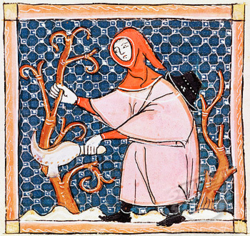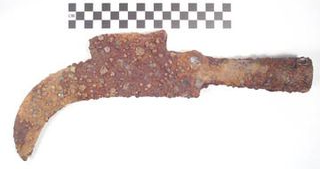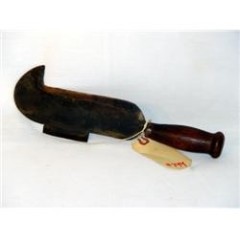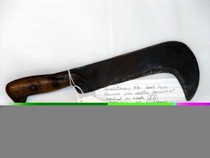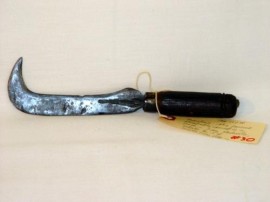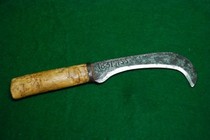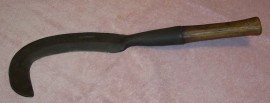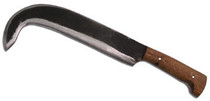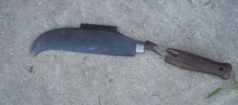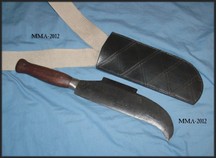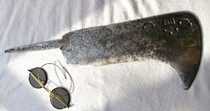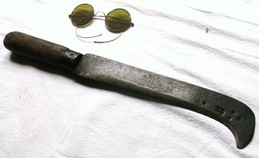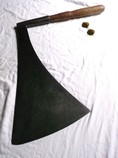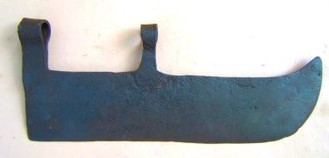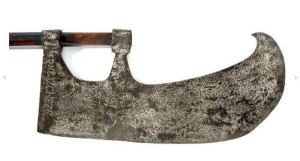Military Billhooks 3
As there appears to be a lot of European billhooks masquarading as Colonial American fascine knives (often at exhorbitantly inflated prices) this section is devoted to the military billhooks of the USA, or those being sold as American fascine knives (either implied or stated in the description).
The billhook was relatively common in the American colonies, and also appears to have been known as a fascine knife during the period of British rule. The few genuine billhooks from this era come from recorded archeological excavations, where they can be placed in context, and there is supporting evidence for their dating. There appears to be many more with questionable provenance, and from their appearance, many seem to be of European origin, and of a much later date than 18th century.
The American War of Independence took place during the period 1775 to 1782, and after the British left the use of the billhook or fascine knife seems to have declined, with the use of the axe ascending. Even in Canada, which remained British and also had (and still has) strong Francophone regions, the billhook is relatively unknown.
This socketed billhook with a back blade from the Mashantucket Pequot Museum & Research Center is almost certainly colonial British in origin, and was probably dropped during a skirmish known as Parker's Revenge in 1775.
This one, which is very similar to the one above, was found at the Hanscom Airforce Base in 2012, and is now in the Minute Man National Historic Park collection. It is also believed to be from the Parker's Revenge skirmish in 1775, when Colonial forces ambushed British forces during an 18 mile march on their way back to Boston from Concord.
This sold in 2004 as a Revolutionary War fascine knife. Starting bid $120, with an estimate of $200 to $400. It is almost certainly a well used English Yorkshire pattern with a strapped handle that has been cut off short. The initials on the blade and the gutter bolt through the handle would probably date it to the 20th century. A close up look at the blade may well reveal an English edge tool maker's stamp.
This Revolutionary War fascine knife from Fishkill NY appears to be French in origin, and no earlier than 19th century. It did not sell in a 2005 auction, but appears to have some provenance attached. Close examination of the ferrule may indicate its age, but the handle may be a later replacement...
This one could be the twin of the one above. It is in the Morristown National Park collection. If they have provenance, it could well be 18th century as stated, but similar, dating from the 19th and 20th centuries, are still to be found in Italy today. (A very similar example pre-dating AD79 was found in the ruins of Pompei, which goes to show how difficult dating can be without other evidence).
Although sold as a Revolutionary Period fascine knife, this is in fact and English slasher head fitted with a short handle. Far from being 18th century, the makers mark (Whitehouse Bros of Cannock) and a Registered Design number would indicate it is late 19th or early 20th century. (I guess the seller did not state which revolution he wss referring to - probably the Russian Revolution c 1905).
Listed as a US Revolutionary War fascine knife in 2012, this remained unsold despite a reserve of $40 and an low estimate of $40 to $80. Its origins remain unclear, but with the spur (for foot pressure) on the back (bottom of the image) it would appear to be an agricultrural tool (marc knife, hay knife or ditching knife). It is nevertheless an intriguing and interesting tool in its own right, well worth a $4o investment.
A good replica model from Jas Townsend model KN-184. It looks well made, with a solid through tang and rivetted hardwood scales, and is good value at $50.
This is also a modern (re-enactment) reproduction of a fascine knife. Unfortunately the maker did not use a full tang, but a short one with the handle secured by a single transverse rivet. The result is the handle and blade parted company in use (the blade narrowly missing the user). The maker has since repaired it and welded a full tang to the stub...
The most commonly quoted reference work for US fascine knives is 'Swords and Blades of the American Revolution' by George C. Newmann. Having just obtained a copy (January 2013), the following comments on his notes are made:
Newmann shows four images of fascine knives on pages 250 and 251.
57K appears to be Italian, although this style of blade decoration is also found in the French Alps, Austria and western Hungary. The ferrule appear to be steel tube, which would indicate a 20th century replacement handle. This type of decorated blade was still being made well into the 20th century.
58K appears to be English in origin, the blade shape being that found in the county of Gloucestershire. The method of manufacture of the ferrule will give a good indication of its age, but on first glance it appears later than Newmann dates it (1775 to 1783).
59K is also certainly English, being a Midlands county double edged pattern (probably Banbury in Oxfordshire). The tapered ferrule and the size stamp (No3) indicates a factory made tool, which again dates it later than Newmann (1750 to 1820) and indicates that it is probably mid to late Victorian.
60K is either Portuguese or Spanish, this shape of blade being found in northern Portugal and western Spain. Similar looking tools are still being made in the 21st century - without provenance I would date this no older than late 19th/early 20th century.
Neumann does not state the origins of these four billhooks. I cannot comment on the rest of the book, but these two pages show how mis-information can be readily spread. Billhooks of all these types may well have been used in the American Revolutionary War, especially as most the white population were of European descent, i.e. from where use of the billhook was, and still is, widespread. However it is unlikely these are actually of that period. Those citing Newmann as a way of identifying their own tools need to undertaken much more detailed first hand research, and not rely on information that was first gathered in the 1970's.
Even finding a tool on a known battle site is no indication of its age. A few years ago I purchased on ebay.de a very rusty blade found by metal detection on the site of a deserted 14th century village in the Black Forest of Germany, and advertised as being 'genuine' 14th century. On cleaning it up it was found to be a 20th century 'all steel' blade, bearing an identifiable maker's mark. It was probably dropped in leaf litter by a forester who was working there sometime between 1920 and 1950...
Now we come to some of my favourite 'howlers' - non billhooks tools included here...
I first saw this nice 20th century German hippe stamped FK on ebay.de in 2008. I bid on it, but was unsuccessful. However I do have several similar older models stamped HK (possibly the father of FK). It is a Siegerland knipp from North Rhine Westphalia. I next saw it in 2009 when it was advertised for sale in the USA for about 5 times what it had previously sold for - it had acquired a 'Certificate of Authenticity' that stated it was American in origin, from Pennsylvania and it had aged about 200 years. When I contacted the seller he agreed that he had been misled, and reduced the price and amended his details. I never did find out who 'authenticated' it...
Sold as pre 1700, this one fetched $282 in September 2013. The makers initials, JM, in an incused box, date this as late 19th, but more probably 20th century - its origin is either Austrian or German..... Sold as "Authentic,300 + YEARS OLD and unconditionally 100% guaranteed pre 1715" - he's 'aving a larf.....
This one was sold in September 2013 as a French Revolution beheading axe - never mind that in the French Revolution they didn't use the axe - the guillotine was the executioner's preferred tool.... Secondly its not an axe, it's a coupe-marc from the Burgundy region, used to cut up the remains of the grapes in the wine presses, and finally it was made in the late 19th century - the maker, Poitevin (à Macon) was working during the 1883 - 1896 period... Some gullible american paid over $500 for it (well it did have a 'certificate of authenticity' and a money back guarantee....)
And finally from the same seller, who also has on offer a good selection of European carpenters' axes posing as battle axes, this French coupe marc from the cider regions of northern France is advertised as A Rare Untouched 15th to 16th Century German Halberd/Polearm and the price is a whopping $1475. It may be early 19th century, but I suspect it is not even that old, it most certainly is not 15th to 16th century, and is most definitely French not German. Its real value is about 30 to 50 euros.
He may be forgiven a little (no, not really) as two very similar French coupe marcs are in the Higgins Armory (sic) Museum at Worcester, Massachusetts, and (mis)labelled as vouges, another sort of polearm.
I recently found this image (November 2013) of another coupe-marc sold by Christies (in France) in 2011. Listed as 17th century it was sold as a halberd shaped like a bardiche - it fetched $2750. The maker's stamp was illegible, but it has a owner's name crudely engraved on the blade. The forge welded eyes show it is early - I'd guess about 1800 to 1850, but would like to see the illegible maker's mark before confirming its age (or lack of)...
I apologise if this section gives the impression that many weapons dealers are attempting to fleece their customers. I am sure most believe that the item they are selling is what the decription says it is; that the provenance backs this up and that the price is reasonable. The problem is twofold: the value of a weapon is usually much higher than that of a mere tool, and there is a general ignorance of the vast range and shapes of (mainly European) edge tools that were still being made and used right up to WW2 (1939 to 1945). Modernisation, especially mechanisation, of farming has made most of these hand tools obsolete, and a tool that was still in common usage in the mid 20th century has some 50 years later become a museum piece in its own right (but it should be in an agricultural museum not an armoury).
Pre 1800 many types of edge tools were converted to polearms, or used as foot-soldiers' weapons. However, after the war ended most soldiers who survived returned to their agrarian life, taking their weapons with them, and using them thereafter as intended, i.e. as a tool. A few may have survived in their changed form, but most will have been used as tools until they wore out, and then scrapped. The vast majority of these 'suspect' edged weapons (mainly polearms) are in fact 19th century tools - not Victorian replicas. The shape of many tools, and the billhook is an excellent example of this fact, remained virtually unchanged for over 2000 years - a Roman billhook would easily be recognised as such today, and a Roman farm or vineyard worker would readily identify a 21st century one.
That a tool can be used as weapon was tragically seen in the Rwandan genocide of 1994, when the weapon of choice for murder and mutilation was the agricultural machete. The purpose of this website is to educate, and hopefully some of the professional dealers and other experts will allow an amateur enthusiast to correct them.
